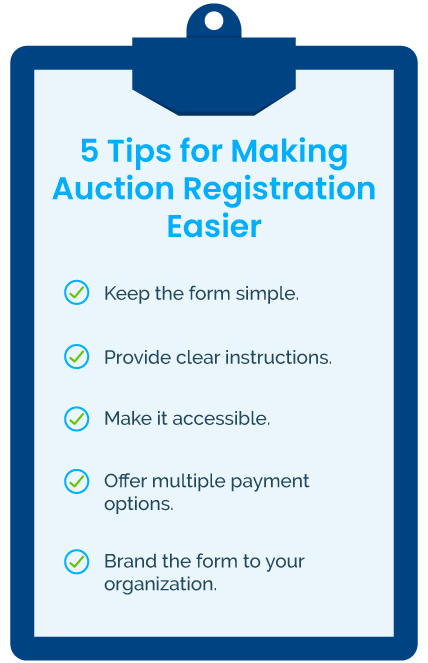
Using Your Website to Boost Your Auction: 5 Strategies
March 19, 2024
From feeling collective support of your nonprofit’s work to experiencing the excitement of someone bidding the highest for a unique item, auctions are fun and effective fundraising events. However, before you can host a successful auction, you need to effectively plan and promote it.
That’s where your nonprofit website comes in! It can be an excellent digital fundraising tool that allows you to check off many to-dos for your fundraising auction. In this guide, we’ll walk through some website strategies your nonprofit can use to boost its next auction:
- Promote your auction using SEO.
- Make registration easy.
- Create a microsite.
- Integrate your auction software.
- Post auction photos on your website.
You may find it useful to reach out to an experienced nonprofit web design consultant for assistance with putting these strategies into play. However, your own skills, a little knowledge of web design, and a can-do attitude will go a long way when following these tips!
1. Promote your auction using SEO.
According to NXUnite, search engine optimization (SEO) is the process of optimizing your website and its written content to perform better on search engines so that it’s more easily found by people searching for terms relevant to your organization and its operations. This is done by ensuring your website offers a great user experience (UX) and building your content around keywords.
There’s a lot that goes into SEO, but the main goal of this kind of marketing is to drive more organic traffic to your website. Here are some tips that can help:
- Target specific keywords. SEO can feel like a losing game if you’re competing with large websites for more general keywords. The good news is that you don’t have to! Instead of targeting the broad keyword “auction,” you’ll probably have better luck with a keyword like “nonprofit auction events in Boston” or a keyword that speaks to your mission, like “children’s advocacy events.”
- Leverage your blog. With a blog, you can write keyword-optimized posts about almost anything, from updates at your organization (like your upcoming auction) to educational pieces about your cause (which can target other important non-auction keywords).
- Optimize for mobile. Google rewards mobile-optimized websites with higher page rankings. This means making your website user-friendly is more convenient for your guests and helps more potential attendees find your auction!
- Share all of your event details. Unlike social media sites and other third-party platforms, your website offers the space to explain all the information about your upcoming event, like whether your auction will be live or silent, registration prices, and more. This is useful for SEO because more comprehensive content is typically favored by search engines.
Note that in general, it can take anywhere from four months to a year to see results from SEO. This makes SEO a great long-game strategy for organizations that have auction-related events that happen on a regular basis, like annual galas.
While you wait to see your content rank higher on search engines, though, you can also direct people to your website content through email, social media posts, QR codes on posters, and more to get the most mileage out of your optimization efforts and increase those RSVPs!
2. Make registration easy.
Your supporters’ auction experience begins when they sign up, so think of your registration form as your chance to make a good first impression. Check out these tips to ensure your registration process is fast, convenient, and easy:

- Keep the form simple. Your form should be short and quick to fill out, asking only for necessary information, such as contact information and payment details. If you need or want to capture additional information, make sure to mark which fields are required and which are optional. For instance, for a fundraising dinner that includes an auction, you might want to mark “Entree Choice” as required and “How did you hear about this event?” as optional.
- Provide clear instructions. Explain what users need to do to register successfully. Also, configure your form so that if a user types something incorrectly, their error is clearly flagged so they can easily correct it.
- Make it accessible. Be considerate of all of your guests. Make your registration forms accessible by using proper color contrast, including alt text in images, and putting all directions in readable text.
- Offer multiple payment options. If you’re charging a registration fee for your event, make sure to provide various ways for your attendees to pay, like credit/debit, Venmo, PayPal, and ApplePay. If you want to encourage further giving, you could also include a suggested donation amount that users can opt into.
- Brand the form to your organization. Website visitors may be wary of your registration form if it appears to have no connection to your nonprofit. To avoid this, brand your form to your organization, using the same color scheme and imagery that you have in other places on your website.
To determine if your registration form is ready to be pushed live or not, have a few of your nonprofit team members test it out and provide feedback.
Then, when your form is ready, provide plenty of links to it from various pages around your website to encourage registrations.
3. Create a microsite.
For many virtual events, you’ll be perfectly fine hosting your registration, live stream, and other event features on your main website. Fundraising auctions, however, are a little more involved and might need a more dedicated space to explain all the details.
Instead of cluttering up your nonprofit’s main website, you might decide it’s better to create a microsite for hosting your auction and use your main website as a promotional tool.
When building your auction’s microsite, you’ll need pages for several core elements, including:
- Your item catalog. A list of item names with a few photos may be easy to set up, but it’s not especially impressive. By contrast, item catalogs require a dedicated page on your website, an engaging layout, and plenty of room to explain all the cool features of each item.
- Information on bidding. Online and mobile bidding can be a little confusing, especially for those new to online auction platforms. To help your guests participate in your auction, you may need to create a page and (maybe even a tutorial video) dedicated to explaining mobile bidding, and you should provide a link to download any necessary apps.
- Auction rules. You and your guests need to be on the same page about how an auction is won. In about nine out of ten cases, you won’t have any problems, but that one hiccup can be resolved quickly if you have a public participation agreement you can point to.
- Sponsor information. Your sponsors make your auction possible, and in return for their generosity, you probably promised them special perks. One of those perks could be free advertising on your event microsite. Create a special page for promoting your sponsors and let your supporters know which businesses or individuals are helping make your auction a success.
- FAQs. Create a space on your website to answer any and all questions your supporters may have about your auction. This allows your supporters to go into the auction experience knowing exactly what to expect and cuts down on the time you need to spend answering questions via email.
Remember to keep your microsite mobile-responsive and accessible just like your nonprofit’s main website. Cornershop Creative also recommends including a clear presentation of your nonprofit’s mission and purpose. This can reinforce your nonprofit’s branding and remind donors what your auction is all about!
Don’t feel like you have to limit your microsite to just these pages. As you start planning the finer points of your auction, you’ll likely discover all sorts of information and features you’ll want to add to your microsite. Get those creative juices flowing!
4. Integrate your auction software.
If you’re hosting an online auction, you’ll need one very important tool on your side: online auction software. But this necessary tool will only work if you integrate it with the rest of your nonprofit’s tech stack, including your website.
There are an impressive number of auction software solutions available. Start weighing your options and noting which software integrates with which platforms. Before making a purchase, confirm with your provider that integration won’t be a problem.
Once you have the right software, connect it to your website, CRM, event software, and any other necessary digital fundraising tools. Practice entering information in these systems to make sure your data is flowing smoothly between your platforms and prevent any potential data loss or user experience issues down the line.
5. Post auction photos on your website.
Before and during your auction, take photos whenever possible so that you can continue promoting your nonprofit even after your event is over. These might be images of your high-value items, pictures of smiling faces over dinner tables, or a photograph of part of your event’s live stream.
Instead of sending a plain text thank-you letter when you follow up with your guests, you can add images taken during your event to remind guests how much fun they had. Plus, a great photo could convince guests to hang onto your thank-you card, which might remind them to attend your next event.
Then, you can turn to your website to post photos of your auction. Snapshots of guests having fun interspersed with photos of high-value items will help attendees recall your auction fondly and encourage others to attend next time. Just remember to ask any guests who appear in the photos for their permission to post them online!
To set your auction up for its best chance at success, look to your website first. These strategies for marketing and managing your event are crucial for a successful auction event!
Get The Latest Updates
Subscribe To Our Monthly Newsletter
No spam, notifications only about new products, updates.
Become a subscriber
Subscribe to our blog and get the latest updates straight to your inbox.


